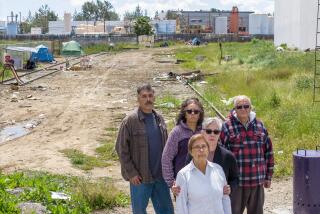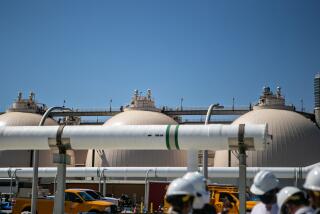EPA’s move to fast-track Orange County groundwater cleanup questioned

When a contaminated aquifer in Orange County made U.S. Environmental Protection Agency Administrator Scott Pruitt’s list of top priority sites for “immediate, intense action,” the local water district was quick to highlight the announcement.
But questions of political favoritism are swirling over Pruitt’s decision in December to prioritize cleaning the Orange County North Basin groundwater pollution plume beneath Anaheim and Fullerton using the federal Superfund program.
Newly disclosed records show the action occurred soon after a meeting among Pruitt, the Orange County Water District and its lawyers that was arranged by conservative radio and television host Hugh Hewitt. The October meeting, documented in emails released under a Freedom of Information Act lawsuit, was first reported Monday by Politico.
In line for cleanup is a water pollution plume stretching more than 5 square miles below Orange County. Decades of industrial operations allowed chlorinated solvents and other chemicals to migrate through the soil and pollute the underlying groundwater in a basin that supplies drinking water to 2.4 million people in 22 cities.
Under the Superfund program, the companies responsible for the pollution would be forced to reimburse the federal government for the cost of remediation.
The EPA named the North Basin site to Pruitt’s personal Superfund priority list in December, explaining at the time that that “basin-wide groundwater cleanup needed quickly to protect drinking water for millions of residents.” It was a move heralded by the Orange County Water District, which said the listing “would allow the cleanup of the site to proceed after many years of negotiations and legal proceedings.”
The following month, the EPA formally proposed placing the site on the Superfund list. If the decision is finalized, the area will join nearly 100 others in California that are among the nation’s most hazardous sites and in line for remediation.
Experts on environmental regulation said the events preceding the site’s fast-tracking raise concerns about the motivation behind the EPA’s decision-making. Pruitt’s responsiveness to a political ally, they say, contrasts with his stance against other California environmental priorities and his push to dismantle protections elsewhere.
Though the Orange County site may warrant federal attention, its expedited selection is unusual, “procedurally fishy” and “looks like a process shortcut that sent this request to the top of the list,” said Sean Hecht, an environmental law professor at UCLA.
“The Pruitt EPA in general has not been particularly responsive, to say the least, to other requests made by California’s environmental officials, making it look more likely that Hewitt may have influenced the process in some way,” Hecht said.
EPA spokesman Jahan Wilcox said Pruitt was originally scheduled to meet with the water district during a trip to California last fall that was later canceled. The water district requested the Washington, D.C., meeting “to brief EPA on the Superfund site’s cleanup efforts and request expedited cleanup,” Wilcox said. “Hugh Hewitt was not present for the meeting.”
Hewitt could not be reached for comment. He told Politico that his law firm represented the water district regarding the site for years, but that he had not participated in that work. Hewitt said he requested the meeting because the water district wanted to brief the new EPA team, and that as a former Orange County resident he wanted the site remediated as soon as possible.
On his radio show Tuesday, Hewitt, a supporter and longtime friend of Pruitt, dismissed media scrutiny of the meeting as “unbelievable” and said “I just didn’t think it was a story.”
Mike Markus, general manager of the Orange County Water District, said the October 2017 meeting was “timely and appropriate” and “consistent with OCWD’s responsibility to manage the basin.”
“Who got the meeting is irrelevant,” Markus said. “It was a legitimate meeting to discuss an issue that is a core function of the EPA. Instead of focusing on Mr. Hewitt’s opinion or his involvement in connecting us with Mr. Pruitt, the focus should be on the fact that federal, state, and local government agencies are working together to clean up pollution in a water-starved region ... This is about making sure a community’s drinking water is safe, the contamination does not spread and that the cost to make that happen is not the burden of innocent citizens.”
Markus described the North Basin groundwater contamination as an ongoing issue for more than a decade and said discussions with the EPA date back to 2014 during the Obama administration. Over many years, he said, district representatives have “met with numerous regulatory staff and elected officials from both sides of the aisle to ensure ratepayers are not strapped with paying for the cleanup.”
State and local agencies in 2014 and 2015 asked for federal help cleaning polluted groundwater. The water district’s meeting with Pruitt followed a 2016 agreement with the EPA, under which the district agreed to fund a $4-million study of the extent of the contamination and how to address it.
In June 2017, California sent a letter to the EPA formally recommending Superfund status for the North Basin site.
Industrial factories, metal processing businesses and dry cleaning facilities in the 1950s, ’60s and ’70s left a legacy of spilled and leaked pollutants — mostly volatile organic compounds including chlorinated solvents, degreasers and other contaminants.
Groundwater in the area is polluted with trichloroethylene, tetrachloroethylene and 1,1 dichloroethylene at levels above Safe Drinking Water Act standards, according to an EPA fact sheet published in January. Contamination from the migrating plume, according to the EPA, has shut down five drinking water wells in the area and threatens dozens of others.
Among the companies that may have contributed to the pollution and could be held liable for cleanup, water district officials said, are Northrop Grumman Corp., Alcoa Corp. and Chicago Musical Instruments.
The North Basin site was assigned a score of 50 on the zero-to-100 hazard ranking system the EPA uses to screen Superfund sites for the threats they pose to health or the environment.
Several other California sites with higher hazard scores were not placed on Pruitt’s personal priority list. A Q&A posted by the agency described it as a “fluid list” that “does not reflect the largest or most contaminated Superfund sites.” Considered instead were those with “critical milestones” or “site-specific issues that will benefit from the administrator’s direct engagement.”
The California Environmental Protection Agency said five sites in the state have been listed under the federal Superfund program since 2011. The most recent addition, made in 2016 by the Obama administration, was the Argonaut mine site where a structurally unstable, century-old dam in the Amador County city of Jackson threatens nearby residents.
More to Read
Start your day right
Sign up for Essential California for news, features and recommendations from the L.A. Times and beyond in your inbox six days a week.
You may occasionally receive promotional content from the Los Angeles Times.








